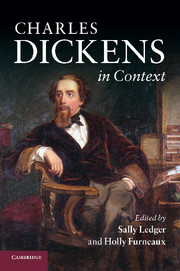Book contents
- Frontmatter
- Contents
- List of illustrations
- Notes on contributors
- Preface
- Notes on references
- PART I LIFE AND AFTERLIFE
- PART II SOCIAL AND CULTURAL CONTEXTS
- 12 Popular culture
- 13 The rise of celebrity culture
- 14 The newspaper and periodical market
- 15 Authorship and the professional writer
- 16 The theatre
- 17 Melodrama
- 18 The Bildungsroman
- 19 Visual culture
- 20 The historical novel
- 21 The illustrated novel
- 22 Christmas
- 23 Childhood
- 24 Work
- 25 Europe
- 26 The Victorians and America
- 27 Educating the Victorians
- 28 London
- 29 Politics
- 30 Political economy
- 31 The aristocracy
- 32 The middle classes
- 33 Urban migration and mobility
- 34 Financial markets and the banking system
- 35 Empires and colonies
- 36 Race
- 37 Crime
- 38 The law
- 39 Religion
- 40 Science
- 41 Transport
- 42 Illness, disease and social hygiene
- 43 Domesticity
- 44 Sexuality
- 45 Gender identities
- Further reading
- Index
41 - Transport
Published online by Cambridge University Press: 05 August 2012
- Frontmatter
- Contents
- List of illustrations
- Notes on contributors
- Preface
- Notes on references
- PART I LIFE AND AFTERLIFE
- PART II SOCIAL AND CULTURAL CONTEXTS
- 12 Popular culture
- 13 The rise of celebrity culture
- 14 The newspaper and periodical market
- 15 Authorship and the professional writer
- 16 The theatre
- 17 Melodrama
- 18 The Bildungsroman
- 19 Visual culture
- 20 The historical novel
- 21 The illustrated novel
- 22 Christmas
- 23 Childhood
- 24 Work
- 25 Europe
- 26 The Victorians and America
- 27 Educating the Victorians
- 28 London
- 29 Politics
- 30 Political economy
- 31 The aristocracy
- 32 The middle classes
- 33 Urban migration and mobility
- 34 Financial markets and the banking system
- 35 Empires and colonies
- 36 Race
- 37 Crime
- 38 The law
- 39 Religion
- 40 Science
- 41 Transport
- 42 Illness, disease and social hygiene
- 43 Domesticity
- 44 Sexuality
- 45 Gender identities
- Further reading
- Index
Summary
During his lifetime, Dickens saw the roads around him becoming ‘macadamised’, or paved. He saw stiff lumbering coaches overtaken by fast, light, more comfortable coaching ‘machines’, as they were sometimes called. And, most importantly, he saw the rise to its peak of a stagecoaching public transport system that within living memory tripled the speed of road vehicles between Britain's major towns and regularised those towns' connections, thus bringing the nation three times closer together. The highway corridors and roadside inns filled with a newly mobile people. Then, in the 1830s and 1840s Dickens saw this nationwide long-distance stagecoaching system rapidly disappear and the direct highways around him empty. New railed roads ridden by coal-eating, steam-driven iron horses, pulling coaches trained together reduplicated the whole system with a new celerity of mobility ‘realising the Arabian Nights in these prose days’, as Dickens marvelled. Along with the long-distance regional transport of stagecoach and rail, short-distance, horse-drawn transport flourished on tributary routes and in the bustling cities, and passenger travel over water gradually shifted from wooden sailing ships to iron and steam boats, eventually also revolutionising international ocean crossings. Throughout his career, Dickens engaged, both in terms of content and form, with this rapid development of the transport system unfolding all around him. Some modern readers and critics have taken the fact that Dickens's novels generally gravitate towards the depiction of coaching (often of the 1820s) as indicating a nostalgia on his part for a premodern past.
- Type
- Chapter
- Information
- Charles Dickens in Context , pp. 334 - 342Publisher: Cambridge University PressPrint publication year: 2011



